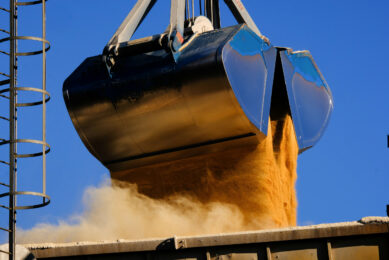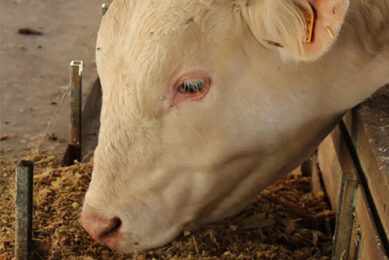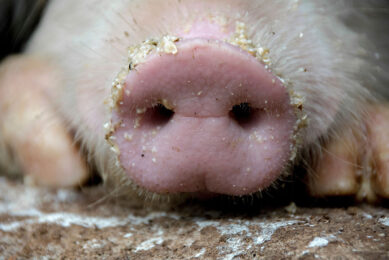“The link between nutrition and health becomes key”
Dr Clifford A. Adams is nutritional services director at Kemin
AgriFoods Europe, part of the Kemin group. The major objective of
the company is the research and development of nutritional
strategies to improve the efficiency of the production of food of
animal origin.
“Perhaps the major concern in animal nutrition 15 years ago was to improve animal performance. Feed was then, as is now, the major economic input in animal production. Minimum cost formulations and the widespread use of antibiotic growth promoters were important aspects of animal nutrition. Over the last 15 years there have been significant improvements in body weights and feed conversion ratios in many animal species. However, today the emphasis has shifted from production efficiency as the major driver to aspects of human food safety, animal welfare and environmental impacts. This has come about from a change in consumer attitudes followed by legislative actions. To some extent, the great success of the animal production industry in delivering large quantities of low cost food to the consumer has also been the architect of some of our own problems. Food prices are at historically low levels and food security is taken for granted by the population at large. There have, nevertheless, also been several serious issues of food safety and human health over the last 15 years, such as antibiotic resistance in pathogenic bacteria, BSE in cattle, Campylobacter and Salmonella in poultry, and genetically modified organisms. These have engaged public opinion and stimulated ever more legislative controls.The increased legislation with the expressed objective ensuring that food produced in the EU is safe and wholesome is obviously important to EU citizens. However, the cloak of food safety has increasingly been used to support new legislative actions, which increase cost and difficulties for the animal producers, but yield little in terms of increased food safety. For example, it is difficult to see how the enormous costs associated with the registration and re-registration of feed ingredients, such as enzymes, organic acids and amino acids, contribute to food safety. This certainly contributes to increased food production costs and will increasingly put EU producers at a disadvantage in the global marketplace. In the next 15 years it is likely that the nutritional control of animal health or nutrition-based health will become more important. Many animal diseases, such as avian influenza, BSE, foot and mouth disease and post-weaning multisystemicwasting syndrome (PMWS), cause serious economic losses and are not easily treated. Furthermore, consumers want food produced from healthy animals, yet at the same time they do not want those animals treated with drugs and pharmaceutical products. The ideal scenario will be a nutritional strategy to maintain health and avoid disease in animals raised for food. This will require much more research and understanding of the relationship between nutrition and health. This will be an interesting and serious challenge.”
Ioannis Mavromichalis is the director of R&D for Nutral, SA., a Provimi Company inSpain . He has also worked as a director of nutrition for SCA Nutrition USA , a Provimi Company in the US . His education and training are based on swine nutrition, with emphasis on piglet nutrition.
“In the area of swine nutrition, the most significant milestones with a worldwide significance must be the advent of zinc oxide (reduced post-weaning diarrhoea and improved growth performance), the emergence of animal plasma (improved post-weaning feed intake), the environmental regulations (altered the way we formulate diets), the ban on antimicrobial
growth promoters and their replacement by organic acids and essential oils, and finally, most recently, the extensive use of biofuel by-products such as DDGS and glycerol. With a more local focus I would also include the use of ractopamine in the USA as a feed management tool to modify carcass characteristics. I think the animal feed industry is more competitive than 15 years ago. It must be because of the simple fact that customers (producers) are now fewer, and in addition they are more sophisticated, larger in size, and have a better understanding of nutrition and its significant effects on profitability. At the same time, the core of being an animal nutritionist (enhance profitability either by reducing cost of production or by improving
animal performance at similar cost), remains the same. The approach we follow has changed because we must now follow new regulations and our work must be more customer-specific as opposed to creating generic products/formulas with a wider application spectrum. There is much collaboration in marketing research, especially regarding additives. Sadly, true meaningful research that advances our knowledge on animal nutrition has seen a drastic decline as a consequence of the change in university funding from public to private sources. Perhaps we are heading towards a balance in both types of research. Looking at the future, it is apparent that energy has made a big comeback. This area of nutrition was of paramount importance in the early pioneering work done mostly in Western Europe at the start of the previous century, but it has been largely neglected since then due to an oversupply of readily available cereals. The projected deficit in cereals, due to their extensive use for biofuel production, will undoubtedlycause dietary energy to be the focus of forthcoming research. I also believe that feed additives will see a decline in use due to their limited and often unpredictable performance, especially in a context where feed costs are predicted to soar! Lastly, the pressure to reduce feed costs will
continue to drive producers towards home-mixing arrangements, which invariably limit their businesses with the established feed industry. On the other side, the continuous increase in feed/environmental/social regulations will further increase the cost of doing business, even for the largest feed/premix/additive manufacturers. The combination of the two will drive both sides to consolidate their businesses to increase their competitive edge.”
Martin Verstegen is officially retired as a professor in animal nutrition at Wageningen University in the Netherlands . However, he is still busy with the programmes of several PhD fellows regarding energy metabolism, digestion, nutrition and health, primarily in monogastric animals.
and how to feed different genotypes (nutrigenomics).”
“Today’s feed formulation is more complex”
Yannig Le Treut is commercial director for France , Belgium , Spain and Portugal for Lallemand Animal Nutrition. Prior to this, Le Treut spent eight years managing the porcine activities of major French porcine cooperatives: first UCANOR and then Agrial. At Lallemand. His primary focus is pig nutrition.
In France , for example, the National Institute for Agronomic Research has a different orientation, focusing on human nutrition issues and applications. Animal nutrition now plays a bigger part in this general goal with less research performed to support animal nutritionists. In parallel, contract research is becoming more important. In addition, feed safety will take up more importance within the next 5 years, with a focus on microbial contaminations. Nutritionists have focused on digestive physiology, but now, especially with AGPs withdrawal, we are becoming more aware of the importance and role of the animal microflora in ruminants, but also in monogastric animals (to farmers I use the saying: “the pig lives around its flora”). The industry will also evolve with the farms: the increased farm sizes driven by socio-economical constraints will have an impact on the way we work. Feed will take on new values and new dimensions. At the same time, the development of the biofuel industry will create a competition for the access of cereals (raw materials prices) and will stimulate the development of on-farm feed production.”
“The use of enzymes has boomed”
Dr Nick Dale is a professor of poultry nutrition at the University of Georgia in the US . His primary focus is on feed ingredient quality, as well as practical problems encountered in the field of poultry nutrition.
increasing use of organic trace minerals, particularly selenium, and the increased pressure to reduce or eliminate routine antibiotic supplementation in animal feeds. Inevitably, there has been a burst of interest in methods to obtain similar benefits with “natural” substances. The diversity of such additives is extreme. In many areas there is increasing prejudice against the use of animal by-product meals in animal feeding. This goes far beyond the use of eliminating ruminant by-products in ruminant feeds, which is to be strictly followed. However, there appears to be in some quarters an interest in producing a “vegetarian chicken”. The motive for producing a “vegetarian chicken”, which will obviously be consumed by “non-vegetarian humans”, defies logic. Over the next 15 years it is safe to anticipate an ever increasing emphasis on reducing the environmental impact of animal production. The continued development of enzymes to further improve digestion of materials used in animal feeds will be an essential part of reducing the unavoidable environmental impact of animal feeding. A basic justification for animal agriculture is that animals can convert feedstuffs not normally consumed by humans into nutritious and aesthetically pleasing human foods. In fact, this has largely been a myth, as the majority of animal feeds consist of grains (which can obviously be consumed by humans) and soybean products (which can clearly be converted into human foodstuffs). Aggressive development of enzymes to enhance the feeding value of ingredients not likely to be consumed by humans (cottonseed meal, animal by-product meals, etc.) will be of immense value. One hopes the development period for such enzymes will be drastically reduced by advances in bio-technology. Of the numerous threats to animal agriculture, one has become especially salient in the past year. While the development of “green fuels” must be encouraged, the practical, and even ethical, removal of fermentable feedstuffs from the human food chain to produce bio-fuels must be seriously questioned. The drastic increase in the price of maize and other grains will affect not only animal agriculture but also the price, and even accessibility, of human foods. While potential problems have always faced the animal feed industry, one must bare in mind the enormous contribution made by animal agriculture to human well-being. The ability of the animal to concentrate proteins from various sources, many of which are unsuitable as human foodstuffs, and convert these into highly nutritious and aesthetically pleasing foods, will certainly continue to be an essential component of agriculture in general. It is indeed fortunate that striking advances in bio-technology can be and are employed by animal agriculture to address questions and threats of ever increasing complexity.”
Lode Nollet is currently providing technical support in the Benelux region and is also responsible for Alltech’s sales in Belgium . Before joining Alltech, Nollet worked as a poultry researcher and nutritionist at the scientific research office of an international premix company.
“When I started working in the feed industry, we mainly depended on the pharmaceutical companies that provided ingredients such as antibiotics, growth promoters, hormones, etc. In addition, the majority of industry research also seemed to come from these companies. The efforts in research and development from pioneering animal feed companies over the last 20 years have totally changed that scenario. The fact that growth promoters are no longer consumer acceptable has driven the research in the development of natural alternatives. Today’s consumers and, more so, multinational supermarket chains have the power. They are directing and dictating the way the industry is moving. The end user is concerned with animal welfare, the environment, safe food and traceability. At the same time, it is more difficult for companies to differentiate themselves on the basis of feed formula alone, compared to 15 years ago. Supermarkets are also dictating what is or is not allowed to be included in feed formulations. The job of the animal nutritionist has changed dramatically and will change even more so in the future. The nutritionist is no longer just a feed formulator; he or she is now more than ever involved in the entire sales process. The nutritionist needs to act as part veterinarian and consultant to the farmer. Fifteen years ago the correct amino acid, energy, protein, vitamin and mineral levels were the most important areas to focus on. Today’s feed formula means including ingredients that not only help
to improve animal performance, but also to ensure continued animal health. Because animal performance has been optimised, there has been a decrease in the margin available for improvement. Nutritionists must now be highly educated with an open and innovative mind. Forexample, the nutritionist of the future must know how nutrigenomics works; feeding the gene, a science that did not exist 15 years ago. The coming years will be mainly dominated by the reduced availability of raw materials that drive up feed prices. Also, feed quality continues to be an issue as more and more by-products are used. Countries dependent on imported raw materials will also suffer the effects of higher prices, which in turn will have a negative impact on their local animal production and thus food production. An increase in the disease sensitivity of animals we breed for top performance will require nutritional support to maintain their health status. These threats (challenges), however, push the industry forward and ensure continued innovation. The raw materials we take for granted today, may no long be viable in the future; however, the industry is already creatively thinking and researching alternatives.”
Chris Kamel is technical and business development manager at Carotenoid Technologies. Focusing on additives and pigments for feeds and foods, his work field includes using new applications and technologies for natural and nature-identical substances.
Dr Peter Surai is a university professor at the Szent István University in Hungary and professor of nutritional biochemistry at the Scottish Agricultural College . Surai’s main area of interest concerns the various aspects of antioxidant and polyunsaturated fatty acid metabolism, including selenium in animal nutrition, reproduction and functional food production.
diseases is proven. Various calculations gave an estimation of about 200 billion free radicals in every cell every day to be produced in physiological conditions. In stress conditions these figures will be substantially higher. A classical view that vitamin E has been the major antioxidant in the animal body has been updated and a concept of the total antioxidant system has been developed. It has been well appreciated that animal diet includes a range of natural antioxidants. For example, there are 8 vitamin E related compounds: 4 tocopherols and 4 tocotrienols. Carotenoids comprise a group of more than 600 individual compounds, while flavonoids include more than 8,000 compounds. It seems likely that every antioxidant in the body has its own role to play, but all antioxidants are interacting with each other building an integrated antioxidant system. For example, vitamin E is “headquarter”, selenium is “chief executive”, carotenoids are “communicating services” and vitamin C is “special forces” of the antioxidant system. The most exciting development in antioxidants has been related to selenium (Se) – the most controversial mineral. On the one hand, it is toxic at high doses and there is a great body of information related
to environmental issues of Se contamination. On the other hand, Se deficiency is a global problem related to increased susceptibility to various diseases of animals and human, decreased productive and reproductive performances of farm animals. Recently 25 selenoproteins have been characterised in human and animal cells. Indeed, glutathione peroxidase (GSH-Px), known for 30 years as major selenoprotein, is in fact one of the big family of selenoproteins and probably is not the most important one. However, Se requirements of humans and animals have been developed based on the GPH-Px activity in response to Se supplementation. Recently it has been shown that when GSH-Px activity is at a maximum, activities of other selenoproteins, such as selenoprotein P and thioredoxin reductase, are not at the maximum expression. This means that old data should be reconsidered and Se requirement should be re-evaluated based on the new developments in this area. In addition, Se interactions with other antioxidants, including vitamin E, need further elucidation. Effects of antioxidants on gene expression opened a new era in antioxidant research.”
CCL research is the department of CCL BV , located in Veghel, the Netherlands , and is specialised in contract research in the field of animal nutrition and animal husbandry. CCL research has specialised research teams for pigs, poultry and ruminants and for the characterisation of feed ingredients, feed additives and feedstuffs.
Source: Feed Mix Magazine Vol. 15 no. 2
“Developments in areas such as genetics, biology, food and feed science and animal health, together with public and political concerns related to the food chain have changed animal nutrition. Biology, and increasingly biochemistry and molecular biology, have enabled us to have more detailed knowledge of mechanisms and complex physiological occurrences in the animal body. In the last decade, more emphasis has been placed on the impact of a healthy intestinal tract (microbial ecosystem), as well as the impact of sub-clinical inflammation in tissues on health and performance. Furthermore, the ban on the use of AGPs in the European Union has forced nutritionists to better consider the interaction between feedstuffs and the digestive system, even at a single tissue, cellular or molecular level. The occurrence of BSE also marked the way we approach animal feed. The prevalence of mad cow disease forced us to formulate diets without animal proteins and to separate production lines by animal species inour factories. We also know that many feed constituents, like NDF fractions, butyrate and glutamine, have biological effects in addition to their known nutritional functions. Also, more knowledge has been gained in using feed enzymes, with phytase now being a standard additive in feed formulations. Balancing amino acid supply at the level of true availability and metabolic needs helped us to reduce the less appreciated environmental side effects of intensive animal husbandry. Besides more knowledge in mode of action of certain ingredients, animal health has become a major aspect in animal nutrition, for both economy reasons and public concern. In this area, more insights have been gained in the crucial importance of feed intake immediately after weaning (and hatch) for life-time health. These new insights have been more available in the last 15 years. The development of the Internet has played a crucial role in intensifying the scientific communication worldwide. It has created more international networks covering specific research areas. This can (and will) be beneficial for research groups all over the world to work together on certain (complex) areas. We therefore see that many multinational companies have reduced fundamental research and rely upon international networks of expertise more than ever.“Internet has played a crucial role in sharing research data”“For the last 15 years there have been tremendous changes in our attitude toward natural antioxidants. Indeed, importance of antioxidants is related to the quickly developing understanding of the role of free radicals in biology and medicine. In fact, detrimental effects of free radicals are well established and their involvement in the development of various“Different attitude to natural antioxidants”“The shift in corn use for ethanol for fuel in order to replace fossil fuels is probably one of the most significant changes of the last few years. This not only has an impact on generations such as ours, but future ones as well. This is also reflected in the role of the animal nutritionist: the job has evolved to a more technical-commercial role. He/she is now the gatekeeper for the entry of new formulations and technologies, where before the procurement (commercial) manager had that role. The nutritionist must look for new opportunities which are effective not only from the zootechnical point of view, but also a cost point of view. Besides the cost issue, the legislation issues have become more important today and will be in the future. This is a positive thing if it does not establish too many restrictions. Too many constraints may be counterproductive as it could suffocate the feed industry. If feed registration dossiers became too stringent, for example, they may favour the bigger companies over the smaller ones, which in my opinion would be counterproductive for the innovation and ingenuity that the industry has seen in the last 15 years. Looking at the future, I expect that more emphasis will be put in areas such as aquaculture. More and more attention will be given by the nutritionist to effects on end-product (meat, milk, etc.) quality and its related human health benefits.”“More emphasis on aquaculture”“Raw materials we take for granted today, may not be available tomorrow”“In reviewing the past one and a half decades, the single most obvious development has probably been with the vast increase in the use of supplemental enzymes. On a worldwide basis, phytase has been most widely adopted, followed by other enzymes to improve energy and nutrient availability (when justified by the presence of corresponding substrate). A new generation of enzymes is beginning to reach the markets, which are focused not on improving nutrient availability, but rather the elimination of deleterious factors naturally found in some feed ingredients. Other prominent developments that have been reviewed include the“The different food safety crises we have seen over the last 15 years, such as BSE, dioxins, Cadmium etc., have deeply changed the practices in the feed industry. This has resulted in ISO certifications, traceability, quality controls and HACCP, for example. Furthermore, the withdrawal of many molecules, such as growth promoters, has lead to the generalisation of biotechnological concepts, such as enzymes (e.g. phytases now present in every monogastric feed). The technology has not evolved much over the last 15 years, but the size of production facilities has increased. They have evolved to serve a formulation concept centred around efficacy (e.g. digestible amino acids and digestible proteins), which is now driven by environmental pressure. While the new safety constraints have increased the costs (quality controls, bacterial contamination control, specialisation of plants and delivery channels), the feed industry has gained in competitiveness. It is probably one of the industries that made the most effort to reduce its costs in the last 15 years. Technology, mechanisation, increased plants sizes, but also the evolution of formulations, has brought more competitiveness. At the same time, the new constraints on safety, traceability and quality have made the job of animal nutritionist more complex. Raw material characterisation has evolved, adding a safety component to the nutritional profile. It is also more complex in terms of formulation: more formulas are available for many species (e.g. the generalisation of multi-phase formulas in poultry and bi-phase formula in pigs). Today, big firms analyse their own raw materials, and the nutritionist is no longer dependant on a “common truth”. In those firms, the formulator is now less of an executive, but has become more involved in upstream activities. The increased knowledge of metabolisms and digestion modes of actions has also lead to a better understanding of the interactions between feed elements that are now taken into account. In Western Europe , animal nutrition research has declined (public and private). Proof being the number of research stations having decreased.“I believe the most significant occurrences in animal nutrition in the last 15 years is the shift from the focus on energy and protein to other biological properties of ingredients, which influence health and behaviour, as well as the shift from level of digestion to rate of digestion. In addition, more interest in aspects related to sustainability is seen today more than 15 years ago. The use of molecular biology techniques, such as nutrigenomics, has gained more interest over the years. In my view, the animal feed industry is more competitive than 15 years ago in the sense that there is more knowledge available on a range of properties in feedstuffs, so there are more ways for a company to distinguish itself from other companies. Fifteen years ago, nutritionist focused on feed formulation on the basis of tables. We now focus on specific properties, which are not yet in tables. At the same time, the farmer has much more knowledge on nutrition, meaning that general knowledge is not enough for today’s nutritionist. Institutes, universities and companies now collaborate less on new animal nutrition research then they did before – governments give less money, which means that institutions can not maintain all specialisations. New knowledge is not so available and so nutritionists each have to make a choice on what topics they want to focus on. Also, new findings come at the junction between different disciplines, so again, a reason for collaboration. You need to have colleagues who you can help and colleagues with another discipline who can help you. In addition, cooperation with universities should not limit the independent approach and/or publication of results by universities. Regarding the legislative issues in animal feed, society wants to have more assurance that food is produced in a society-acceptable manner. This is a good thing because food should be produced in a proper way. Food producers should be transparent – tracking and tracing is a good method. The areas that I think will be given the most attention in the future are nutrition in relation to quality of product and quality of production environment, the increased involvement of the society, safety and acceptability, the consequences of biofuel for nutrition“There is more knowledge available than ever before”“Our work has to be more customer-specific”












